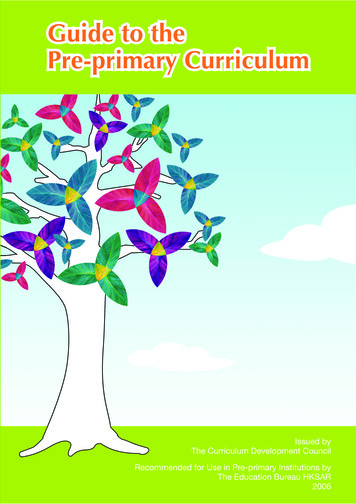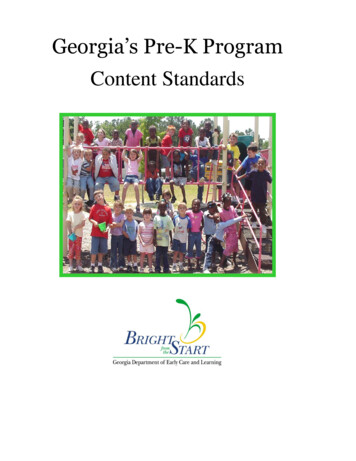
Transcription
Guide to thePre-primary CurriculumIssued byThe Curriculum Development CouncilRecommended for Use in Pre-primary Institutions byThe Education Bureau HKSAR2006
ContentsForewordChapter 1Introduction1.11.21.31.41.5Chapter 25-13Position of Pre-primary EducationCore Value of Pre-primary Education – Child-centrednessAims of the GuideBasic Principles of the Pre-primary Education CurriculumDirections and Strategies for Curriculum DevelopmentCurriculum Framework2.12.22.32.42.5Chapter 34Aims of this ChapterCurriculum GoalsDevelopmental Objectives for Young ChildrenLearning Areas – What to learn?Learning Objectives and Principles of Teaching forDifferent Learning Areas – What to learn? What to teach?Curriculum Planning3.1 Self-evaluation – Conditions, strengths and limitations3.2 Knowing the Stakeholders Well – Children and parents3.3 Designing the Curriculum – Child-centred, comprehensiveand well-balanced, and adopting a play-based strategy3.4 Establishing Mechanisms for Curriculum Review and MonitoringChapter 4Learning and Teaching4.1 Key Factors in Learning and Teaching –How to teach? How to learn?4.2 Approaches to Learning and Teaching –Learning through play4.3 Catering for Special Needs and Learning Differences –Respect children’s right to learn and tap their full potential4.4 Making Use of Resources – Widen the learning 15456
Chapter 5Assessment57-655.1 Purposes of Assessment – To promote learning anddevelopment5.2 Principles of Implementing Assessment – How to assess?5.3 Scope of Assessment – What to assess?5.4 Modes of Assessment – Who should assess?5.5 Records and Reports on the Progress ofChildren’s Learning – Student PortfoliosChapter 6Settling in and Transition to Primary6.1 Adaptation to School Life – From home to school6.2 Interface between Kindergarten and Primary School –From kindergarten to primary schoolChapter 7Home-School Co-operation596061636567-71687073-787.1 Modes of Home-School Co-operation7.2 Principles of Implementation7.3 References747677Exemplars79AppendicesAppendix 1:Appendix 2:Appendix 3:Appendix 4:Appendix 5:Appendix 6:Appendix 7:Appendix 8:80-100Developmental Characteristics ofChildren from 0-2 Years OldDevelopmental Characteristics of Childrenfrom 2-6 Years OldBrief Descriptions and Examples of BasicSkills Applicable to Pre-primary EducationA Proposed Set of Values and Attitudes forIncorporation into the School CurriculumA Study on Chinese Handwriting at theKindergarten LevelActivity Plan and ReviewLife-wide LearningChildren’s Behaviours that Require ConcernReferences8086939495979899101-103Membership List3104
ForewordThis Curriculum Guide is prepared by the Curriculum Development Council(CDC) of Hong Kong for Pre-primary Institutions serving children aged from2 to 6. The Curriculum Development Council is an advisory body givingrecommendations to the Hong Kong Special Administrative Region Governmenton all matters relating to curriculum development for the school systemfrom kindergarten to sixth form. Its membership includes heads of schools,practising teachers, parents, employers, academics from tertiary institutions,professionals from related fields or related bodies, representatives from theHong Kong Examinations and Assessment Authority and the Vocational TrainingCouncil, as well as officers from the Education Bureau.Pre-primary institutions are encouraged to adopt the recommendations setout in this Curriculum Guide, where appropriate and with due considerationof their own circumstances and needs, to achieve the pre-primary educationobjectives.Comments and suggestions on the Guide to the Pre-primary Curriculum arewelcome and may be sent to the Secretary of the CDC Committee on EarlyChildhood Education by post, fax or email.Address:13/F, Wu Chung House, 213 Queen’s Road East,Wan Chai, Hong KongFax:25735299 / 25754318Email:scdokpkg@edb.gov.hk4
Chapter 1Introduction5
1Introduction1.1Position ofPre-primaryEducationPre-primary education (Note1 ) is an important stage which lays the foundationfor life-long learning and whole person development, and serves as the startingpoint of formal education. It articulates with primary, secondary and tertiaryeducation to form an entire spectrum of education. The Guide to the Preprimary Curriculum, endorsed by the Curriculum Development Council ofHong Kong, has been in use since its publication in 1996. Following the latestdevelopments in education in the world as well as the momentum of the HongKong education system and curriculum reforms at the beginning of this century,pre-primary education in Hong Kong has undergone significant changes.Pre-primaryEducationTrends ofGlobalDevelopmentin yEducationHong KongEducationSystemandCurriculumReforms1.1.1Trends of GlobalDevelopment in EarlyChildhood EducationImportance of early learningResearch into the human brain shows that the period from birth to the ageof 8 is a critical phase for brain development and therefore the best timefor learning. The influence of the external environment is crucial to braindevelopment. If a safe and accepting environment with abundant sensorystimulation is available in early childhood, children will have positive braindevelopment which is beneficial to their future learning.According to the theory of multiple intelligences, there are many aspects ofhuman intelligence and every individual has varied strengths. Pre-primaryinstitutions should provide a diversified learning environment for children todevelop their different potentials.1Pre-primary education in Hong Kong refers to the stage of education before primary school for children.6
Numerous studies on learning theory have shown that children learn graduallyand construct knowledge with the assistance of adults. From the perspectiveof constructivist learning theory, children are active and self-motivated in theirlearning process. Teachers have to take up the roles of facilitator, motivator andsupporter to help children learn and grow.1.1.2Hong KongEducation Systemand CurriculumReformsLaying the foundation for life-long learning and whole persondevelopmentLearning for Life, Learning through Life: Reform Proposals for the EducationSystem in Hong Kong, published by the Hong Kong Education Commissionin 2000, emphasised the importance of early childhood education as thefoundation for life-long learning. It proposed initiatives for enhancing theprofessional standards of early childhood teachers, reinforcing qualityassurance mechanisms, and improving the primary one admission systemto prevent the tendency of inputting excessive anxiety in early childhoodeducation. Subsequently, another curriculum reform paper, entitled Learningto Learn - The Way Forward in Curriculum Development, further elaboratedon a learner-focused approach in the curriculum. Every student is capable oflearning and should enjoy the basic and essential learning experiences. In thisregard, the pre-primary curriculum should provide children with high qualityand integrated pre-primary education and care service.1.1.3The Ecology of EarlyChildhood Educationin Hong KongOur strengthsWith increased in-service and pre-service training opportunities and upgradedacademic qualifications of kindergarten teachers being required by theGovernment, the professional standards of Hong Kong kindergarten teachersare being systematically enhanced.Following the reform of the primary one admission system, schools nolonger enrol pupils on the basis of based on their ability. As a result, preprimary institutions now have greater room to design their own curriculumand free children from unnecessary drilling and pressure. In addition, closercommunication and co-ordination with primary schools help children adapt toprimary school life.In response to the recommendations on education reform, the EducationBureau has compiled a series of Performance Indicators (Pre-primaryInstitutions) as a tangible and effective tool for pre-primary institutions’self-evaluation and external review. Furthermore, the Working Party onHarmonisation of Pre-primary Services has also co-ordinated the establishmentof kindergartens and child-care centres. All these measures will contribute tothe evolution of a quality culture in pre-primary institutions.7
With the impact of global educational trends, institutions and academics havebegun to attach significance to scientific research. They have also activelyexperimented with innovative learning and teaching strategies, home-schoolco-operation and different modes of institutional administration, with a view toenhancing the overall quality of teaching and pre-primary education.1.2Core Value ng and respecting children is an important principle ofearly childhood education.Children’s learning and development are mainly influenced by family, schooland society. Under the major premise of understanding and respectingchildren, appropriate co-ordination among the three parties will enable childrento develop their potential and lead them to a healthy life. By developing goodlearning habits and interest in learning, children will be well prepared for lifelong learning.SchoolFamilyChildSociety1.2.1Children as LearnersChildren are born to be learners and their development possessesspecific patterns and characteristics.Children’s development possesses specific patterns and characteristics. Wehave come to understand children’s characteristics and developmental needsfrom the perspective of child development psychology, as well as from thecontexts of their families and social culture.Children are at the core of the learning process. They are born to be learnersand with the ability to construct knowledge. Their development and learningare greatly influenced by the people and things they encounter at home, atschool and in society.8
1.2.2Family EducationParents are children’s first teachers as well as school’s crucial partnersfor nurturing children.Families are the key setting in which children’s characters are shaped.Children’s development of personality, self-image, values and attitudes isgreatly influenced by parents and other family members.Parents’ knowledge of early childhood education, expectations and parentingstyle may influence children’s functioning in ways to be reflected later inlife. These include, for instance, their self-care ability, social attitude andlearning process in schools, as well as their compatibility with the community.Therefore, the family is an important pillar of children’s development and familyparticipation is essential for the success of early childhood education.1.2.3School EducationSchool is a miniature of society, and a bridge between family life andsocial life.Pre-primary institutions need to (i) understand children’s family backgrounds,and establish partnership with parents and other key family members; (ii)understand the social environment and needs, and utilise community resourcesappropriately; (iii) grasp the current trends of early childhood education in orderto define their mission and plan the curriculum. Pre-primary institutions shouldalso provide children with care and appropriate learning opportunities whichcater for children’s developmental needs according to their potential, in orderto stimulate their interest in learning and foster a balanced development inethical, intellectual, physical, social and aesthetic aspects. By these means,children will be well-prepared for life and become proactive, self-motivated andresponsible citizens as well as life-long learners.1.2.4Social EnvironmentSocial needs affect pre-primary education policies, whereas social cultureaffects parents’ requirements for pre-primary education.Pre-primary institutions must observe the social environment in order tohelp children develop their potential and prepare for future learning. Prior tothe establishment of a pre-primary institution, the sponsoring body shouldunderstand holistically the needs of society in mapping out strategies thatconform to Government policy while adhering to the child-centred principle.Children are the leaders of tomorrow. The challenge ahead for early childhoodeducation is how to proactively meet the demand for talent in our future society.In a co-operative and harmonious environment, society, family and school canwork together to build a bright future for children.9
1.3Aims of the Guide1.3.11.3.21.3.3This Guide aims at developing, for young children aged from 2 to 6, acurriculum framework which is focused on whole person development andlife-long learning, under the guiding principles described in Learning to Learn- The Way Forward in Curriculum Development and in line with the directions ofHong Kong’s educational reforms.Every pre-primary institution has its own mission, resulting in different operationmodes and teaching approaches in the curriculum adopted. The curriculumframework proposed by this Guide provides general directions for curriculumdevelopment for pre-primary practitioners: to widen the space for learning;to be child-centred; to respect individual differences; to promote motivationfor learning and to care for children’s needs. Pre-primary institutions need toformulate their own curriculum based on this Curriculum Guide and transformit into appropriate learning experiences for children.Based on children’s developmental abilities and needs as well as the needsof society, this Guide sets out, for pre-primary institutions’ reference andadoption, the areas and objectives of learning and the principles of teaching.1.4BasicPrinciples of thePre-primaryEducationCurriculumThe Pre-primary education curriculum should be formulated according to thebasic principles of “children’s development” and “children’s learning”. Teachers’understanding of these two aspects will directly affect curriculum planningand arrangements for learning and teaching. Teachers can draw on these twosources of knowledge as the basis for educating children.1.4.1Children’sDevelopmentHow do children develop?Children develop at varying rates, and have different interests and abilities.Teachers should understand and respect the unique developmental patternof every child, in order to foster children’s initiative in further developing andenhancing their knowledge and ability.10
i.Children’s development is mainly influenced by three factors: genetics,environment and education. While only limited change can be made tothe genetic factor, the other two require good collaboration among thefamily, school and the whole of society in order to enable children to growhealthily.ii. There are common principles in children’s growth and development. Preprimary practitioners must understand the growing process of childrenand the developmental characteristics of different ages, so as to developappropriate learning objectives and plan the curriculum according tochildren’s needs. For teachers’ reference, the appendix “DevelopmentalCharacteristics of Children” (Note2) in the Appendices of this Guide sets outthe major developmental characteristics in physical, intellectual, linguistic,social and emotional aspects of children aged between 2 to 6. Moreover,a chart of the developmental characteristics of children from birth tothe age of 2 has also been included in order to provide teachers with acomprehensive understanding of children’s development.iii. A child’s development is a gradual process. The developmental patterns ofmost children are congruent with their age. However, as growth rates differ,children also have different abilities and varying performance in differentaspects. In addition, because of children’s curiosity, self-motivation andability to construct knowledge, their learning ability may, when given anappropriate environment in which to develop, even exceed the expectationsof teachers. Therefore, when referring to the Appendices on children’sdevelopmental characteristics, teachers are advised to make flexible useof the information and draw relevant verification in light of their everydayobservations, in order to provide appropriate and sufficient opportunities forchildren’s development. As mentioned in the Performance Indicators (Preprimary Institutions): Domain on Children’s Development, it is not necessaryto set out specific performance indicators for each age level.iv. Discrepancies are at times discerned among the requirements of society,the expectations of parents and the physical and mental development ofchildren. If such discrepancies can be reduced to an acceptable level,education can function as a facilitating factor for development. Teachers’grasp of professional knowledge in the field of pre-primary education isnecessary. In addition, a good mastery of basic knowledge of all areas oflearning allows teachers to adapt to children’s diverse learning needs anddevelop their multi-intelligence.2See Appendix 1 and Appendix 2 for details11
1.4.2How do ChildrenLearn?“Learning by doing” , “Learning through play”,Interest is the driving force for learning;Play is happy learning experience;Sensory activities are the media of learning.Observation, exploration, thinking and imagination are the essential learningapproaches.A sense of achievement reinforces further learning.i.Children are active learners who are curious and interested in exploration.Given proper resources and adults’ assistance, children can constructknowledge on their own. A safe, comfortable, enjoyable and challengingenvironment is conducive to children’s learning.ii. Children’s learning is influenced by the factor of growth. They are not ableto learn far beyond their ability. Children can learn well provided that thelearning experience matches their development.iii. Children learn through their life experiences, sensory stimulation andinteresting activities. Through play, they can learn in a self-motivated,committed, pleasurable, relaxing and effective manner.1.4.3Teachers need to be familiar with children’s development and learning, in order to:i.understand children’s behaviour;ii. have appropriate expectations and requirements towards children, which inturn helps them to formulate reasonable school rules and policies;iii. organise learning activities, taking into account the appropriate level ofdifficulty and meeting children’s interests, needs and abilities;iv. understand children’s individual differences, and both the generality anduniqueness of children’s development, in order to cater for each individual’sneeds.1.4.4This Guide provides directions and principles for the pre-primary educationcurriculum. It gives pre-primary practitioners sufficient room to bring theirprofessional knowledge into full play, and enables them to design thecurriculum according to children’s needs within an open and flexible framework.12
1.5Directions andStrategies ing the rising standard of professionalism in the field of pre-primaryeducation, pre-primary institutions are encouraged to develop a curriculumtailored to their own needs. They are advised to use the fundamental conceptsand principles set out in this Guide as a base, to follow the directions below,and to adopt appropriate strategies. The Education Bureau will also providesupport, where appropriate.In designing their curriculum, institutions have to take into account theirbackground, characteristics and mission, as well as children’s abilities anddevelopmental needs, and be in line with the framework provided in Chapter 2of this Guide. Institutions should also adopt appropriate teaching approachesand collaborate closely with parents.Pre-primary institutions should develop children’s learning abilities and potentialthrough informal learning which is integrated, open, flexible and appropriate tocatering for children’s developmental needs and interests. Children’s abilitiesshould be developed through play activities that are inspiring and fun.Pre-primary institutions should design appropriate learning activities in differentlearning areas to develop children’s basic skills and foster the development ofpositive values and attitudes.Pre-primary institutions and tertiary institutions should work together inexperience sharing or the exchange of teaching and learning experiences forthe benefit of the profession, by doing research or collaborative projects andcollecting exemplars of good practice.13
14
Chapter 2CurriculumFramework15
2Curriculum Framework2.1Aims of thisChapterThe first Chapter of this Guide introduced the basic rationale of early childhoodeducation and the key principles of the pre-primary curriculum. Based on thisrationale and these principles, the present Chapter further sets out the preprimary curriculum framework. This serves as an overall guideline for preprimary institutions to develop their own curriculum, including the specificlearning contents and learning and teaching strategies tailored for childrenof different ages, with a view to providing children with appropriate care andguidance.The aim of early childhood education is to foster children’s whole persondevelopment. In light of this, the core of the curriculum framework is the fourdevelopmental objectives for young children, namely “Physical Development”,“Cognitive and Language Development”, “Affective and Social Development”and “Aesthetic Development”. These objectives need to be achieved throughsix learning areas, which are “Physical Fitness and Health”, “Language”, “EarlyMathematics”, “Science and Technology”, “Self and Society” and “Arts”.All kinds of learning include the three key elements, namely “knowledge”, “skills”and “attitudes”, and these are also emphasised in the pre-primary curriculum.It should be noted, however, that in the early childhood stage, knowledgeacquisition involves mainly the development of basic concepts, rather than thestudy of specific subjects. The above objectives and learning areas align withthe curriculum goals of “Balanced Development” and “Learning to Learn”.Pre-primary institutions may refer to Chapter 3 – “Curriculum Planning” andChapter 4 – “Learning and Teaching” for instructions on using this centralframework in implementing their curricula. “Assessment” will then be discussedin Chapter 5.16
Pre-primary Curriculum FrameworkGoalsTo nurture children to attain all-round development in the domains of ethics, intellect,physique, social skills and aesthetics, so as to prepare them for life.To stimulate children’s interest in learning and cultivate in them positive learning attitudes,in order to lay the foundation for their future learning.Developmental Objectives & Learning Areas for ChildrenDevelopmentalObjectivesPhysical DevelopmentCognitive and Language DevelopmentAffective and Social DevelopmentAesthetic DevelopmentPrinciples of Curriculum PlanningAppropriate Plan for Learning,Learning and Teaching Strategies andAssessment Appropriate to Children’sDevelopmental NeedsWhole Person DevelopmentPleasurable & Effective Learning17
2.2Curriculum GoalsThe overall aims of education set out by the Education Commission in 2000 are:“To enable every person to attain all-round development in the domains ofethics, intellect, physique, social skills and aesthetics according to his/herown attributes, so that he/she is capable of life-long learning, critical andexploratory thinking, innovating and adapting to change”Since early childhood education is the foundation for whole person developmentand life-long learning, the curriculum goals of this stage are summarised as: To nurture children to attain all-round development in the domains of ethics,intellect, physique, social skills and aesthetics, and to develop good habits,so as to prepare them for life; and To stimulate children’s interest in learning and cultivate in them positivelearning attitudes, in order to lay the foundation for their future learning.2.3DevelopmentalObjectives forYoung ChildrenWith regard to children’s developmental needs, the objectives for the physical,cognitive and language, affective and social, and aesthetic development ofchildren are described below. Pre-primary institutions should take into accountthe interrelations among these four domains as well as their own situations incurriculum planning.2.3.1PhysicalDevelopmentChildren use their five senses and their body to perceive and interact with theoutside world. These serve also as tools to receive and deliver messages.Therefore, all learning and communication rely very much on body controlability, the development of gross and fine motor skills and the application ofsensory ability. The following developmental objectives should be consideredfor pre-primary curriculum planning:i.To develop children’s sensory perception and abilities of concentration andobservation.ii. To cultivate in children good habits, self-care ability and a healthy life-style.18
iii. To facilitate the development of children’s gross and fine motor skills.iv. To enable children to understand the limits of their physical capability anddevelop awareness for self-protection.2.3.2Cognitive andLanguageDevelopmentThe cognitive development of children begins in infancy. They constructknowledge of the world through physical activity and sensory experience.The sensory-perceptual ability of children, as well as the use of languageand symbols, marks the beginning of the preliminary stage of children’slearning. These abilities enable children to construct knowledge and developtheir intelligence through real-life situations and experiences. The relevantdevelopmental objectives of this domain include:i.to arouse and fulfill the curiosity of children, and to cultivate in theman inquisitive and proactive attitude towards things and people aroundthem.ii. to develop children’s simple logical concepts in mathematical literacy, soas to help them in analysis, reasoning, judgement and problem-solving.iii. to develop children’s abilities in language and thinking.2.3.3Affective and SocialDevelopmentEveryone has his/her own thoughts, emotions, senses and imagination, whichmake an individual unique. These personal traits, together with other learningelements such as cognition, skills and attitudes, that an individual acquires inlater learning, lead to a more comprehensive, whole person development.The sensory-perceptual ability of children makes them inquisitive and activelearners. If coupled with positive reinforcement, these attributes lead topleasurable learning. Furthermore, the experience of social interaction givesthem a sense of identity, self-confidence and self-esteem. It also encouragesthem to be more proactive and self-motivated in learning and in establishingsocial interaction with others. This developmental cycle is conducive to wholeperson development, which is the ultimate aim of education. The relevantdevelopmental objectives of this domain include:i.to encourage and help children understand their thinking and emotions,and express their feelings and needs through appropriate use of languageand non-linguistic means.ii. to help children develop a positive self-concept and build up self-esteem,self-confidence, a sense of achievement and an optimistic attitude.19
iii. to enrich children’s life experiences and strengthen their interpersonal andcommunication skills.iv. to assist children to attain a balance between their personal interestsand those of the community, to learn to establish good interpersonalrelationships through negotiation and co-operation, and to accept basicsocial values and behaviourial norms.v. to foster in children positive attitudes towards people and an understandingof the roles and responsibilities of individuals in the family, school, societyand country.vi. to cultivate children’s care for society, awareness with respect toenvironmental protection and respect for different cultures.2.3.4AestheticDevelopmentAesthetic sensitivity is cultivated through observation and feelings. Imaginationis stimulated when one observes the environment with one’s senses andcompares the forms of different things. Children express their inner thoughts,feelings, emotions and imagination through the language of different media.The objectives of arts education for early childhood include:i.to allow children to explore different art media and symbols in anaesthetically rich and diversified environment.ii. to enrich children’s sensory experiences and encourage them to expresstheir thoughts and feelings.iii. to stimulate children’s creative and imaginative powers, and encouragethem to enjoy participating in creative works.iv. to enhance children’s quality of life and foster their interests in life byguiding them to appreciate the surrounding environment.20
2.4Learning AreasWhat to learn?The objectives of children’s developmentcan be achieved through the following sixlearning areas:ValuesandAttitudes1. Physical Fitness and Health2. LanguageLearningAreas3. Early Mathematics4. Science and TechnologyBasicSkills5. Self and SocietyKnowledge6. ArtsThe learning areas are components of the curriculum. They addressdevelopmental objectives for young children in different curriculum domains,and provide a framework for reviewing different learning elements. They aredesigned for the construction of knowledge and to provide children withcontexts for the development and application of basic skills, values andattitudes. The classification into different learning areas is not intended topromote teaching by subjects or to prepare for this practice which will beadopted in primary schools. Rather, it is used as a means for providing easyreference for teachers in curriculum planning and review, and to ensurea comprehensive and balanced implementation. In terms of pre-primarycurriculum planning, an integrated curriculum across different learning areasoffers both education and care for young children. It also allows teachersgreater flexibility in devising learning and teaching
1.1 1 6 1 Pre-primary education in Hong Kong refers to the stage of education before primary school for children. Pre-primary education (Note1) is an important stage which lays the foundation for life-long learning and whole person development, and serves as the starting point of formal education. It articulates with primary, secondary and tertiary










